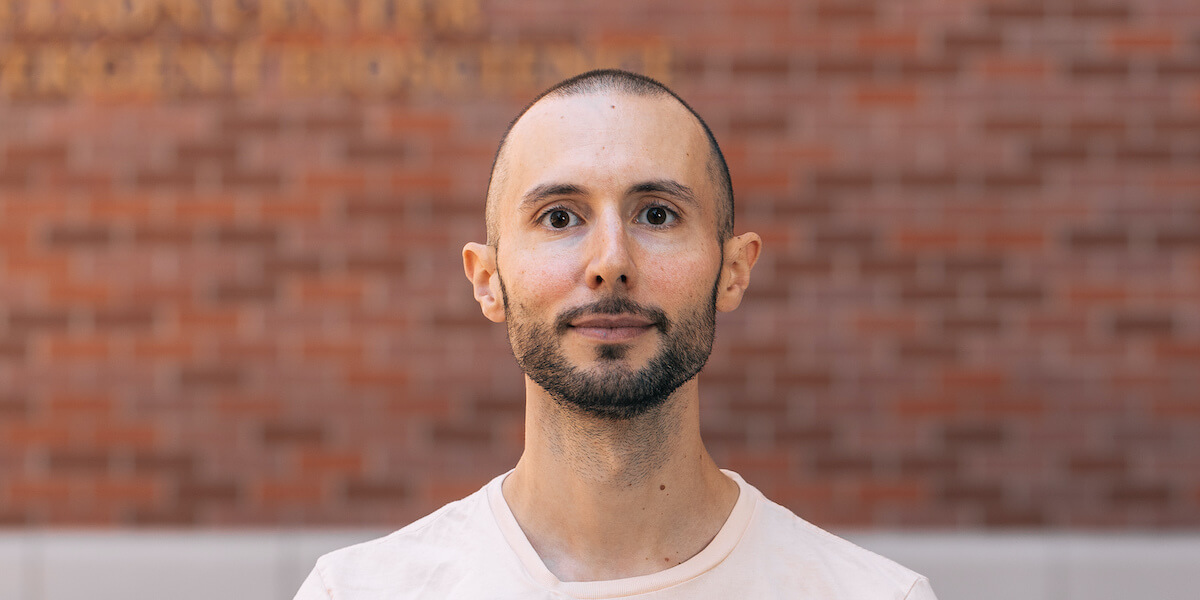
Associate Professor Giacomo Nannicini brings his optimization expertise from IBM Research to the Daniel J. Epstein Department of Industrial and Systems Engineering. Image/Juan Miche Rosales.
Giacomo Nannicini, associate professor of industrial and systems engineering, agrees that his field of research — quantum algorithms and optimization — is never dull. His work gives him a roadmap to help address critical challenges, in areas as diverse as quantum computing, routing and architecture.
His software and algorithms have been used by one of Europe’s largest real-time traffic and mobility information groups and in the IBM Watson Studio data science platform.
Nannicini comes to the USC Viterbi School of Engineering this fall as a new research and teaching faculty member, following many years working in industry on optimization algorithms, including six years with IBM Research. Nannicini’s vast background will strengthen the Daniel J. Epstein Department of Industrial and Systems Engineering’s capacity in optimization and algorithms for quantum computing.
“It’s very difficult to get bored with optimization. These are the sort of tools and frameworks that can be applied to many different problems,” Nannicini said.
From his early days as a Ph.D. student, Nannicini has been fascinated with optimization, and started working on large-scale, shortest path problems — in which an algorithm is designed to find the optimal path between points. This is the theoretical framework that underpins map navigation technology such as Google Maps, taking into account many variables, such as terrain and traffic information, in order to find the most efficient path between two points.
Nannicini soon found that optimization challenges were everywhere, and his background could be applied to a range of fields, such as energy, transportation and supply chains.
“Another area in which I’ve worked is architectural design optimization. Some problems in architecture, especially building design, can be informed by performance metrics. These are generally energy performance metrics or various metrics around the quality of life inside a building, such as the luminosity inside and how heat changes during the day,” Nannicini said. “All these things can be figured out through simulation, with complex simulation software that lets you input your parameters for your building design, your windows, and location, and then you can see what the heat profile and energy consumption will look like.”
Some of Nannicini’s work concerns algorithms to find optimal values for these input parameters.
Nannicini said that these algorithms are useful for machine learning as well. He said that training machine learning models to address problems often requires a time-consuming process of figuring out the right parameters to input into a model.
“The way you set the parameters determines how well you can train the model,” Nannicini said. “While at IBM, I worked on algorithms and software to automate this process.”
Nannicini has a Ph.D. in computer science from École Polytechnique in France. He has held visiting positions at the Tepper School of Business at Carnegie Mellon University, and at the Sloan School of Management at MIT, as well as an assistant professor role in the Engineering Systems and Design Pillar at the Singapore University of Technology and Design.
He has been honored with a number of accolades for his research, including the 2021 Beale–Orchard-Hays prize, the 2015 Robert Faure prize, and the 2012 Glover-Klingman prize.
Nannicini’s recent work within IBM’s quantum algorithms group was focused on designing and understanding the power of quantum optimization algorithms.
As he begins his role at USC Viterbi, Nannicini is eager to forge collaborations with experts working in quantum computing and optimization algorithms, both within USC and in industry.
“USC has a strong group of people in other departments, such as electrical engineering and physics, but I think it is quite a new area for industrial and systems engineering,” Nannicini said. “I plan to start developing classes, and also see how I can tie in collaborations from other departments and industry.”
Published on September 30th, 2022
Last updated on September 30th, 2022









